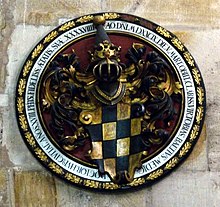Nasal stroke
The nasal line and the reduplication line are abbreviations (additional characters) in the form of an overline , a tilde or a hook. They are not diacritical marks , just abbreviations. A line over vowels , which shows their length, is the macron .
In Unicode there are two blocks for such overlines:
- U + 0304 : M̄, m̄, N̄, n̄ or
- U + 0305: M̅, m̅, N̅, n̅
Nasal stroke
Like most abbreviations in German, the nasal stroke was adopted from the Latin treasure trove of abbreviations in the Middle Ages . It probably came into the Latin writing culture from Greek, where it was used especially at the end of the line for ν ending with a syllable , e.g. μακρο̅ = μακρον ; As an abbreviation for the final syllable m , the nasal stroke appears in ancient Latin texts. In Latin texts from the Middle Ages and the early modern period, it mostly stands above vowels and replaces a subsequent nasal ( m or n ) or a syllable that ends with a nasal as a suspension symbol . Examples: stultu̅ = stultum ; homine̅ = ho̅i̅e̅ = hominem ; cu̅ = cum ; ta̅ = tam ; tam̅ = tamen .
The tilde above the Spanish ñ goes back to the nasal stroke as well as the til , which indicates the nasalization of a vowel in Portuguese (see nasal vowels in the Portuguese language ).
The nasal stroke often has the same or a similar shape as additional symbols with a different meaning, e.g. p̅ = prae ; q̅ = quae ; e̅ = est . In the noun sacra , the entire contraction is usually swept over, for example ΘΣ stands for Θεός (God).
Reduplication stroke
The reduplication line stands over consonants such as m or n and indicates their duplication . For example, "Heaven" means "Heaven". The reduplication stroke increases the legibility of the German Kurrent script considerably.
literature
- Elke von Boeselager: Writing: Basic knowledge. Hahnsche Buchhandlung, 2004, ISBN 3-7752-6131-1 , p. 57 ff.
- Bernhard Bischoff: Palaeography of Roman antiquity and the western Middle Ages. 3. Edition. Erich Schmidt Verlag, 2004, ISBN 3-503-07914-9 , p. 202 ff.
Individual evidence
- ^ Paul Arnold Grun: Keys to old and new abbreviations . CA Starke, Limburg / Lahn 2002, ISBN 3-7980-0357-2 .
